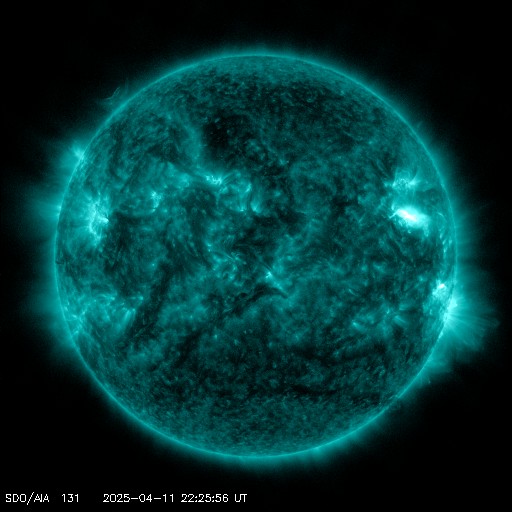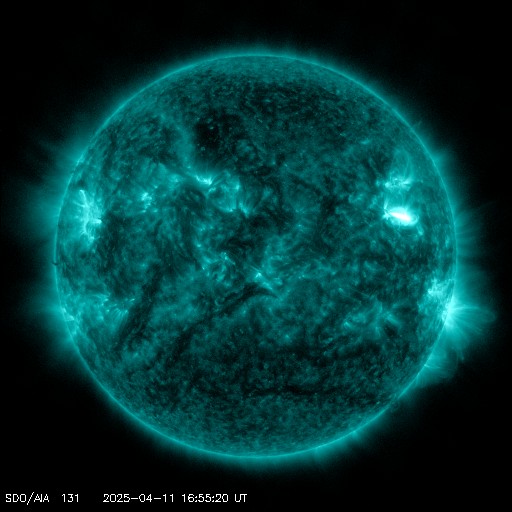Viewing archive of Saturday, 10 April 2004
Solar activity report
Any mentioned solar flare in this report has a scaling factor applied by the Space Weather Prediction Center (SWPC). Because of the SWPC scaling factor, solar flares are reported as 42% smaller than for the science quality data. The scaling factor has been removed from our archived solar flare data to reflect the true physical units.
Report of Solar-Geophysical Activity 2004 Apr 10 2200 UTCPrepared by the NOAA © SWPC and processed by SpaceWeatherLive.com
Joint USAF/NOAA Report of Solar and Geophysical Activity
SDF Number 101 Issued at 2200Z on 10 Apr 2004IA. Analysis of Solar Active Regions and Activity from 09-2100Z to 10-2100Z
Solar activity was very low. Region 588 (S15W38)
contains the only sunspots on the visible disk. This region
maintains a reverse polarity beta magnetic configuration, but has
been quiet since producing a C2 flare and CME at 09/2040Z. No other
significant activity or changes were observed.
IB. Solar Activity Forecast
Solar activity is expected to be low
to very low. Isolated C-class flares are possible from Region 588.
IIA. Geophysical Activity Summary 09-2100Z to 10-2100Z
The geomagnetic field was quiet to unsettled. Solar wind speed was in
gradual decline following yesterday's CME impact. Speed declined
from a peak near 570 km/s at 09/0505Z to near 400 km/s late in the
period. A sharp discontinuity in solar wind plasma and IMF
measurements occurred at 10/1925Z. This was likely the
interplanetary shock associated with the C7 flare and CME on 08
April. Solar wind speed following the shock ranged from 500 to 540
km/s, but the IMF BZ was mostly northward. The greater than 2 MeV
electron flux at geosynchronous orbit reached high levels again this
period.
IIB. Geophysical Activity Forecast
The geomagnetic field is
expected to be quiet to active. Occasional active periods are
expected on 11 April following today's CME arrival. Updated LASCO
imagery reveal another Earth-directed CME associated with
yesterday's C2 flare at 09/2040Z. A geomagnetic response is likely
on 12 April, but the disturbance should be limited to occasional
active periods. Mostly quiet to unsettled conditions are expected on
13 April.
III. Event Probabilities 11 Apr to 13 Apr
| Class M | 05% | 10% | 10% |
| Class X | 01% | 01% | 01% |
| Proton | 01% | 01% | 01% |
| PCAF | green | ||
IV. Penticton 10.7 cm Flux
Observed 10 Apr 088 Predicted 11 Apr-13 Apr 090/095/100 90 Day Mean 10 Apr 109
V. Geomagnetic A Indices
Observed Afr/Ap 09 Apr 011/016 Estimated Afr/Ap 10 Apr 015/012 Predicted Afr/Ap 11 Apr-13 Apr 020/020-010/015-005/010
VI. Geomagnetic Activity Probabilities 11 Apr to 13 Apr
| A. Middle Latitudes | |||
|---|---|---|---|
| Active | 40% | 30% | 15% |
| Minor storm | 25% | 10% | 05% |
| Major-severe storm | 15% | 01% | 01% |
| B. High Latitudes | |||
|---|---|---|---|
| Active | 45% | 35% | 25% |
| Minor storm | 35% | 15% | 10% |
| Major-severe storm | 20% | 05% | 01% |
All times in UTC
Current data suggests there is a slight possibility for aurora to appear at the following high latitude regions in the near future
NuukReykjavik
Latest news
Latest forum messages
More topicsSupport SpaceWeatherLive.com!
A lot of people come to SpaceWeatherLive to follow the Sun's activity or if there is aurora to be seen, but with more traffic comes higher server costs. Consider a donation if you enjoy SpaceWeatherLive so we can keep the website online!

Latest alerts
Friday, 11 April 2025
22:39 UTC - Solar flare
Moderate M1.05 flare
22:24 UTC - Hemispheric Power Index
The OVATION model predicts the Hemispheric Power Index to reach 50GW at 23:16 UTC
22:24 UTC - Radio Blackout
Minor R1 radio blackout in progress (≥M1 - current: M1.05)
17:09 UTC - Solar flare
Moderate M1.08 flare
16:51 UTC - Radio Blackout
Minor R1 radio blackout in progress (≥M1 - current: M1.04)
Space weather facts
| Last X-flare | 2025/03/28 | X1.1 |
| Last M-flare | 2025/04/11 | M1.0 |
| Last geomagnetic storm | 2025/04/06 | Kp5 (G1) |
| Spotless days | |
|---|---|
| Last spotless day | 2022/06/08 |
| Monthly mean Sunspot Number | |
|---|---|
| March 2025 | 134.2 -20.4 |
| April 2025 | 141.4 +7.2 |
| Last 30 days | 137.1 -3 |




